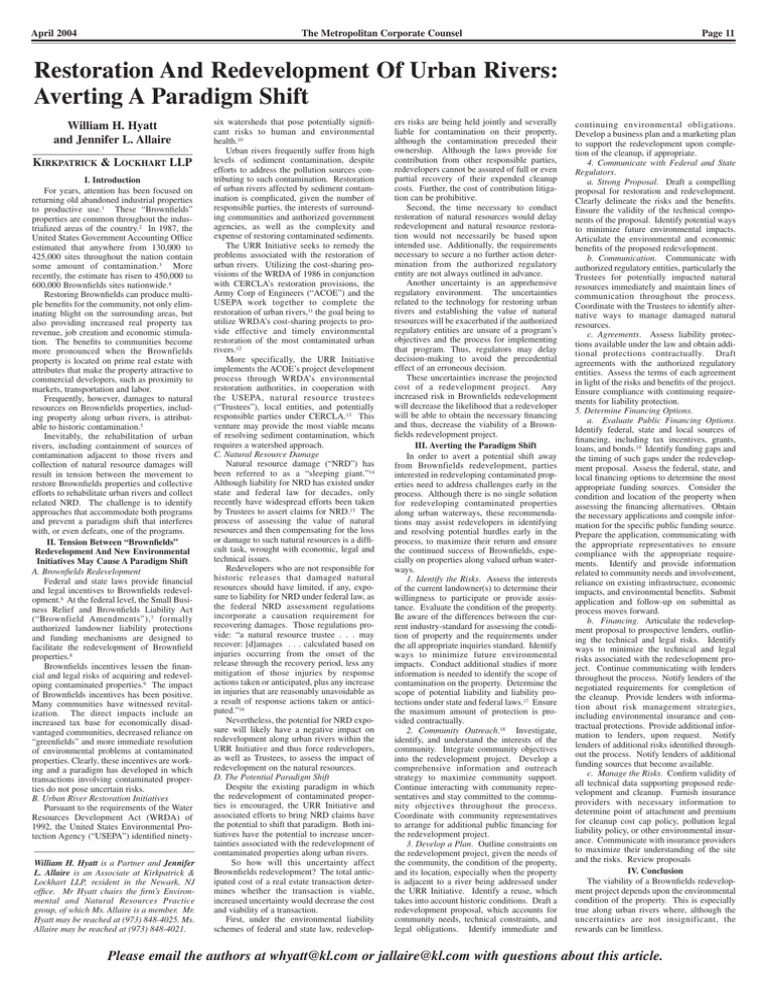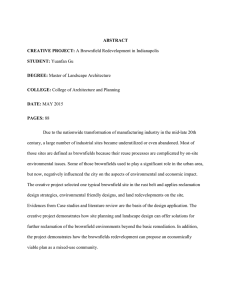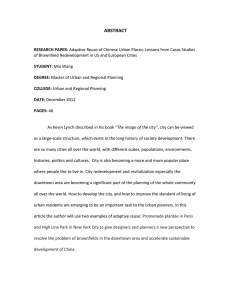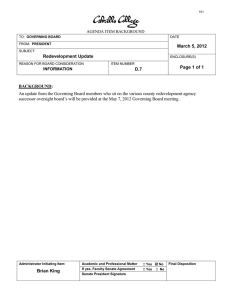Document 13424906
advertisement

April 2004 The Metropolitan Corporate Counsel Page 11 Restoration And Redevelopment Of Urban Rivers: Averting A Paradigm Shift William H. Hyatt and Jennifer L. Allaire KIRKPATRICK & LOCKHART LLP I. Introduction For years, attention has been focused on returning old abandoned industrial properties to productive use.1 These “Brownfields” properties are common throughout the industrialized areas of the country.2 In 1987, the United States Government Accounting Office estimated that anywhere from 130,000 to 425,000 sites throughout the nation contain some amount of contamination.3 More recently, the estimate has risen to 450,000 to 600,000 Brownfields sites nationwide.4 Restoring Brownfields can produce multiple benefits for the community, not only eliminating blight on the surrounding areas, but also providing increased real property tax revenue, job creation and economic stimulation. The benefits to communities become more pronounced when the Brownfields property is located on prime real estate with attributes that make the property attractive to commercial developers, such as proximity to markets, transportation and labor. Frequently, however, damages to natural resources on Brownfields properties, including property along urban rivers, is attributable to historic contamination.5 Inevitably, the rehabilitation of urban rivers, including containment of sources of contamination adjacent to those rivers and collection of natural resource damages will result in tension between the movement to restore Brownfields properties and collective efforts to rehabilitate urban rivers and collect related NRD. The challenge is to identify approaches that accommodate both programs and prevent a paradigm shift that interferes with, or even defeats, one of the programs. II. Tension Between “Brownfields” Redevelopment And New Environmental Initiatives May Cause A Paradigm Shift A. Brownfields Redevelopment Federal and state laws provide financial and legal incentives to Brownfields redevelopment.6 At the federal level, the Small Business Relief and Brownfields Liability Act (“Brownfield Amendments”), 7 formally authorized landowner liability protections and funding mechanisms are designed to facilitate the redevelopment of Brownfield properties.8 Brownfields incentives lessen the financial and legal risks of acquiring and redeveloping contaminated properties.9 The impact of Brownfields incentives has been positive. Many communities have witnessed revitalization. The direct impacts include an increased tax base for economically disadvantaged communities, decreased reliance on “greenfields” and more immediate resolution of environmental problems at contaminated properties. Clearly, these incentives are working and a paradigm has developed in which transactions involving contaminated properties do not pose uncertain risks. B. Urban River Restoration Initiatives Pursuant to the requirements of the Water Resources Development Act (WRDA) of 1992, the United States Environmental Protection Agency (“USEPA”) identified ninetyWilliam H. Hyatt is a Partner and Jennifer L. Allaire is an Associate at Kirkpatrick & Lockhart LLP, resident in the Newark, NJ office. Mr Hyatt chairs the firm’s Environmental and Natural Resources Practice group, of which Ms. Allaire is a member. Mr. Hyatt may be reached at (973) 848-4025. Ms. Allaire may be reached at (973) 848-4021. six watersheds that pose potentially significant risks to human and environmental health.10 Urban rivers frequently suffer from high levels of sediment contamination, despite efforts to address the pollution sources contributing to such contamination. Restoration of urban rivers affected by sediment contamination is complicated, given the number of responsible parties, the interests of surrounding communities and authorized government agencies, as well as the complexity and expense of restoring contaminated sediments. The URR Initiative seeks to remedy the problems associated with the restoration of urban rivers. Utilizing the cost-sharing provisions of the WRDA of 1986 in conjunction with CERCLA’s restoration provisions, the Army Corp of Engineers (“ACOE”) and the USEPA work together to complete the restoration of urban rivers,11 the goal being to utilize WRDA’s cost-sharing projects to provide effective and timely environmental restoration of the most contaminated urban rivers.12 More specifically, the URR Initiative implements the ACOE’s project development process through WRDA’s environmental restoration authorities, in cooperation with the USEPA, natural resource trustees (“Trustees”), local entities, and potentially responsible parties under CERCLA.13 This venture may provide the most viable means of resolving sediment contamination, which requires a watershed approach. C. Natural Resource Damage Natural resource damage (“NRD”) has been referred to as a “sleeping giant.”14 Although liability for NRD has existed under state and federal law for decades, only recently have widespread efforts been taken by Trustees to assert claims for NRD.15 The process of assessing the value of natural resources and then compensating for the loss or damage to such natural resources is a difficult task, wrought with economic, legal and technical issues. Redevelopers who are not responsible for historic releases that damaged natural resources should have limited, if any, exposure to liability for NRD under federal law, as the federal NRD assessment regulations incorporate a causation requirement for recovering damages. Those regulations provide: “a natural resource trustee . . . may recover: [d]amages . . . calculated based on injuries occurring from the onset of the release through the recovery period, less any mitigation of those injuries by response actions taken or anticipated, plus any increase in injuries that are reasonably unavoidable as a result of response actions taken or anticipated.”16 Nevertheless, the potential for NRD exposure will likely have a negative impact on redevelopment along urban rivers within the URR Initiative and thus force redevelopers, as well as Trustees, to assess the impact of redevelopment on the natural resources. D. The Potential Paradigm Shift Despite the existing paradigm in which the redevelopment of contaminated properties is encouraged, the URR Initiative and associated efforts to bring NRD claims have the potential to shift that paradigm. Both initiatives have the potential to increase uncertainties associated with the redevelopment of contaminated properties along urban rivers. So how will this uncertainty affect Brownfields redevelopment? The total anticipated cost of a real estate transaction determines whether the transaction is viable, increased uncertainty would decrease the cost and viability of a transaction. First, under the environmental liability schemes of federal and state law, redevelop- ers risks are being held jointly and severally liable for contamination on their property, although the contamination preceded their ownership. Although the laws provide for contribution from other responsible parties, redevelopers cannot be assured of full or even partial recovery of their expended cleanup costs. Further, the cost of contribution litigation can be prohibitive. Second, the time necessary to conduct restoration of natural resources would delay redevelopment and natural resource restoration would not necessarily be based upon intended use. Additionally, the requirements necessary to secure a no further action determination from the authorized regulatory entity are not always outlined in advance. Another uncertainty is an apprehensive regulatory environment. The uncertainties related to the technology for restoring urban rivers and establishing the value of natural resources will be exacerbated if the authorized regulatory entities are unsure of a program’s objectives and the process for implementing that program. Thus, regulators may delay decision-making to avoid the precedential effect of an erroneous decision. These uncertainties increase the projected cost of a redevelopment project. Any increased risk in Brownfields redevelopment will decrease the likelihood that a redeveloper will be able to obtain the necessary financing and thus, decrease the viability of a Brownfields redevelopment project. III. Averting the Paradigm Shift In order to avert a potential shift away from Brownfields redevelopment, parties interested in redeveloping contaminated properties need to address challenges early in the process. Although there is no single solution for redeveloping contaminated properties along urban waterways, these recommendations may assist redevelopers in identifying and resolving potential hurdles early in the process, to maximize their return and ensure the continued success of Brownfields, especially on properties along valued urban waterways. 1. Identify the Risks. Assess the interests of the current landowner(s) to determine their willingness to participate or provide assistance. Evaluate the condition of the property. Be aware of the differences between the current industry-standard for assessing the condition of property and the requirements under the all appropriate inquiries standard. Identify ways to minimize future environmental impacts. Conduct additional studies if more information is needed to identify the scope of contamination on the property. Determine the scope of potential liability and liability protections under state and federal laws.17 Ensure the maximum amount of protection is provided contractually. 2. Community Outreach.18 Investigate, identify, and understand the interests of the community. Integrate community objectives into the redevelopment project. Develop a comprehensive information and outreach strategy to maximize community support. Continue interacting with community representatives and stay committed to the community objectives throughout the process. Coordinate with community representatives to arrange for additional public financing for the redevelopment project. 3. Develop a Plan. Outline constraints on the redevelopment project, given the needs of the community, the condition of the property, and its location, especially when the property is adjacent to a river being addressed under the URR Initiative. Identify a reuse, which takes into account historic conditions. Draft a redevelopment proposal, which accounts for community needs, technical constraints, and legal obligations. Identify immediate and continuing environmental obligations. Develop a business plan and a marketing plan to support the redevelopment upon completion of the cleanup, if appropriate. 4. Communicate with Federal and State Regulators. a. Strong Proposal. Draft a compelling proposal for restoration and redevelopment. Clearly delineate the risks and the benefits. Ensure the validity of the technical components of the proposal. Identify potential ways to minimize future environmental impacts. Articulate the environmental and economic benefits of the proposed redevelopment. b. Communication. Communicate with authorized regulatory entities, particularly the Trustees for potentially impacted natural resources immediately and maintain lines of communication throughout the process. Coordinate with the Trustees to identify alternative ways to manage damaged natural resources. c. Agreements. Assess liability protections available under the law and obtain additional protections contractually. Draft agreements with the authorized regulatory entities. Assess the terms of each agreement in light of the risks and benefits of the project. Ensure compliance with continuing requirements for liability protection. 5. Determine Financing Options. a. Evaluate Public Financing Options. Identify federal, state and local sources of financing, including tax incentives, grants, loans, and bonds.19 Identify funding gaps and the timing of such gaps under the redevelopment proposal. Assess the federal, state, and local financing options to determine the most appropriate funding sources. Consider the condition and location of the property when assessing the financing alternatives. Obtain the necessary applications and compile information for the specific public funding source. Prepare the application, communicating with the appropriate representatives to ensure compliance with the appropriate requirements. Identify and provide information related to community needs and involvement, reliance on existing infrastructure, economic impacts, and environmental benefits. Submit application and follow-up on submittal as process moves forward. b. Financing. Articulate the redevelopment proposal to prospective lenders, outlining the technical and legal risks. Identify ways to minimize the technical and legal risks associated with the redevelopment project. Continue communicating with lenders throughout the process. Notify lenders of the negotiated requirements for completion of the cleanup. Provide lenders with information about risk management strategies, including environmental insurance and contractual protections. Provide additional information to lenders, upon request. Notify lenders of additional risks identified throughout the process. Notify lenders of additional funding sources that become available. c. Manage the Risks. Confirm validity of all technical data supporting proposed redevelopment and cleanup. Furnish insurance providers with necessary information to determine point of attachment and premium for cleanup cost cap policy, pollution legal liability policy, or other environmental insurance. Communicate with insurance providers to maximize their understanding of the site and the risks. Review proposals IV. Conclusion The viability of a Brownfields redevelopment project depends upon the environmental condition of the property. This is especially true along urban rivers where, although the uncertainties are not insignificant, the rewards can be limitless. Please email the authors at whyatt@kl.com or jallaire@kl.com with questions about this article. “Brownfields” are properties with real or perceived environmental contamination that hampers redevelopment efforts and encourages development in suburban “greenfields.” See GAO, Report to the Chairman, Committee on Commerce, House of Representatives, Brownfields: Information on the Programs of EPA and Selected States (Dec. 2000). 2 Population Growth and Decline in City Neighborhoods, Urban Institute (Dec. 2002); Community Development: Reuse of Urban Industrial Sites (Letter Report, 06/30/95, GAO/RCED-95-172). 3 Superfund: Extent of Nation’s Potential Hazardous Waste Problem Still Unknown (GAO/RCED88-44, Dec. 17, 1987). 4 From Brownfields to Housing: Opportunities, Issues, and Answers, Northeast-Midwest Institute (Oct. 2003). 5 An estimated 5 to 10 percent of the nearly 500,000 existing Brownfields are located beside a waterway. See Integrating Sediment Cleanup and Brownfields Redevelopment, Northeast-Midwest Institute (2001). 6 New Jersey Spill Act (“NJ Spill Act”), N.J.S.A. ß 58:10-23.11g(d) (2003); NY Environmental Conservation Law (“NY ECL”) ß 15-3109 (2003); NY ECL ß 27-1409 (2003); Conn. Gen. Stat. ß 22a-433 (2003); Conn. Gen. Stat. ß 22a-452b (2003); Conn. Gen. Stat. ß 22a-452e (2003). 7 Pub. L. No. 107-118, 115 Stat. 2356 (Jan. 11, 2002). 8 Comprehensive Environmental Response Compensation and Liability Act (“CERCLA”), 42 U.S.C. ßß 9601(39); 9604(b)(k) (providing funding); 9601(35) (landowner liability protection); 9601(40) (bona fide prospective purchaser liability protection); 9607(q) (contiguous property liability protection); 9607(r) (bona fide prospective purchaser liability protection); 9628(a) (providing funding assistance to states). 9 egal incentives include liability protections for prospective purchasers, contiguous property owners and innocent landowners intended to counter the effect joint and several liability schemes had on redevelopment of contaminated property. See generally CERCLA ß 107(a). And financial incentives range from tax benefits for innocent parties that incur environmental restoration costs to grants for innocent parties undertaking the environmental restoration of contaminated properties 10 See generally, The Incidence and Severity of Sediment Contamination in Surface Waters of the United States, Volume I, National Sediment Quality Survey (EPA 823-R-97-006) (evaluating data from sixty-five percent of the 2,111 watersheds in the continental United States). 11 See Memorandum of Understanding between ACOE and USEPA, July 2, 2002. 12 See WRDA of 1996, 104 P.L. 303, ßß 203 (cost sharing for feasibility studies), 210 (cost sharing for environmental projects). 13 WRDA of 1996, 104 P.L. 303, ß 204 (restoration of environmental quality); WRDA of 1999, 106 P.L. 53, ßß 209 (beneficial uses of dredged materials), 210 (aquatic ecosystem restoration), 211 (wastershed management, restoration and development), 224 (environmental dredging). 14 Hyatt, William, Won, Emily, Natural Resource Damages, the Sleeping Giant Awakens (Feb. 2003). 15 ee generally NJDEP, Policy Directive 2003-07, Subject: Natural Resource Damages (September 2003); Ceour d’Alene Tribe v. ASARCO Inc., 280 F. Supp. 2d 1094 (D. Idaho 2003). 16 43 C.F.R. ß11.15 (2004); see also NJ Spill Act, N.J.S.A. 58:10-23.11g(c)(1); NY ECL, ß 27-1421 (2003); Conn. Gen. Stat.ßß 22a-6a, 22a-16a (2003). 17 See supra, note 7; see also supra note 6. 18 See generally, Community Involvement in Brownfields Redevelopment, Bartsch, Charles (March 2003). 19 or example, the USEPA Programs include the Brownfield Cleanup Revolving Loan Fund (funds to governments to create revolving loan funds), Site Assessment and Cleanup Grants (fund a variety of pre-cleanup environmental activities), Clean Water State Revolving Loan Funds (used by states to obtain loans of up to 20 years); United States Dep’t of Housing and Urban Development (“HUD”) Programs include the Community Development Block Grants (CDBG), Section 108 Loans, Brownfield Economic Development Initiative (BEDI), Home Investment Partnerships Program; Economic Development Administration Programs include the Public Works and Economic Development Program, the Economic Adjustment Program; and ACOE Programs include the Continuing Authorities Program (the authority used to conduct the URR Initiative). 1





